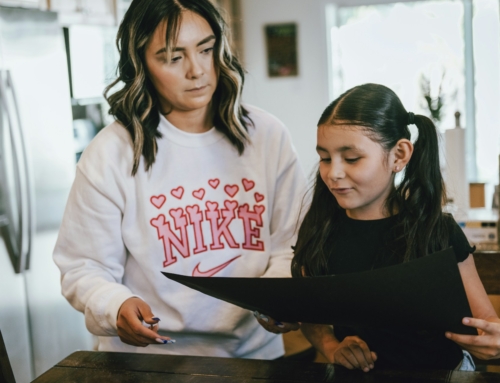Take a moment to think back on yourself as a child. Think about your relationships with your parents or caregivers. What were they like? Did you feel safe and secure around them? Was your heart met with delight? Were your desires honored with curiosity and healthy discipline? Did they attune to you when you were upset or crying? Did they comfort you and bring you back to a calm or regulated place?
Insecure-avoidant attachment defined
To ask the question, “What is insecure-avoidant attachment?” is to engage these core areas and narratives around desire, delight, safety, attunement, and curiosity. More specifically, it is to engage these core places where the need was not fully met by a parent or caregiver.
 To have an avoidant attachment is to ultimately avoid the need or desire for dependence on anyone. It is what it sounds like: avoiding attachment altogether. However, the avoidance doesn’t simply end there. People with an avoidant attachment style have learned over time to make themselves distant from their own emotions, wants, and desires.
To have an avoidant attachment is to ultimately avoid the need or desire for dependence on anyone. It is what it sounds like: avoiding attachment altogether. However, the avoidance doesn’t simply end there. People with an avoidant attachment style have learned over time to make themselves distant from their own emotions, wants, and desires.
As we will see in this article, this behavior is not random. Meaning, the process of avoiding attachment has been shaped, molded, and formed through repeated interactions. It is a narrative embedded in a person’s beliefs about themselves and about how they navigate wanting intimacy in their relationships.
And this is the narrative: “I am alone and on my own. I cannot depend on anyone to meet my needs.” It is an embodied narrative of deep loneliness, despair, and a longing to be seen and known. It is an internal state that is marked by abandonment and suppressed desire which can be traced back to childhood.
How it comes about
As we develop from infancy to childhood and into adulthood, we start in a vulnerable place. We are vulnerable because we are completely dependent on others to meet our every need. Emotional and physical needs are chief among them.
We need our parents and caregivers to feed us. We need our parents and caregivers to comfort us when we are upset or dysregulated. We need our parents and caregivers to provide a safe base from which we can explore, learn about the world, and grow. It is in these vulnerable places where the seeds that become avoidantly attached behaviors are sown.
How we respond to these types of events or ruptures has a direct correlation with how we have formed our relationships with our parents or other caregivers. Fundamentally, the experience of deep-seated loneliness, despair, and longing are not random. Rather they are a combination of a child’s heart-level desires for intimacy, care, and comfort that were never met with welcome, delight, attunement, or curiosity by his or her parents.
Counselor and podcaster Adam Young put it this way, “When the child’s caregiver is often unavailable, dismissive, or rejecting, the child will develop an avoidant attachment…when the child becomes distressed, his caregiver does not provide sufficient comfort, care, and connection.”
In this description, we can begin to see how and where the seeds of unmet desire, despair, loneliness, and longing are planted. Here we can also begin to understand the narrative of, “I am alone and on my own. I cannot depend on anyone to meet my needs.” Again, the avoidantly attached individual’s felt experiences of loneliness, despair, and longing are not random. They are embodied, and there are a library’s worth of stories to support their experience.
Its roots in childhood
As you may imagine, digesting a narrative of loneliness and distrust for care at a young age takes a great toll on a child. The reality, while the child is not aware of it, is that the avoidance expressed by their parent is much more about the parent’s inability to handle their own emotions than the child being too needy. Yet, this is exactly what gets communicated to the child through the parent’s dismissiveness or rejection.
This repeated behavior on the part of the parent is interpreted by the child as shame or guilt for having any emotional needs at all. Shame and the pain that accompanies it is a powerful teacher for the child. The repeated rejection or dismissal teaches the child that it is useless to rely on someone to meet their needs, wants, or desires for intimacy, connection, and attunement.
Instead, the child is left to hold their deep longing and desire along with the pain of those desires remaining unfulfilled. The writer of Proverbs puts it well when he says, “Hope deferred makes the heart sick, but a desire fulfilled is a tree of life.” (Proverbs 13:12)
The child is therefore put in a terrible bind. How do I get my emotional needs met and maintain a relationship with my mom or dad? They are forced to navigate their parent’s fragility while trying not to feel or express their emotions, wants, and needs. In other words, the child must choose between remaining authentic in their emotional experience or adapting themselves to maintain some sort of attachment to their parents. This choice is as impossible as it sounds.
Therefore, in the case of insecure-avoidant attachment, the child adapts to his or her environment by avoiding closeness with their parent or caregiver. Eventually, he or she stops trying to express their wants and needs. They have learned that their wants or needs do not ultimately matter to their caregiver.
The core narrative
Here we come back to the core narrative mentioned above, “I am alone and on my own. I cannot depend on anyone to meet my needs.” As this core narrative continues to take root, the child becomes self-reliant and begins to adopt the view that he or she is strong and independent.
In the midst of this, another tragedy occurs. The child begins to numb his or her desire for deep emotional connection and thus shuts down the longing for attachment. Deep down this person begins to believe that it is too painful to hope that a caregiver will suddenly become accepting, available, and responsive to them.
It is at this point that he or she becomes disconnected from their own emotions, hopes, dreams, and desires altogether. This process of completely detaching emotionally is directly connected to the shame and pain the child internalizes upon being rejected and dismissed by their caregiver. Why hold onto desire or longing when all they know about both is pain?
 Insecure-avoidant attachment ultimately has its roots in the parent’s inability to provide adequate comfort, care, and attunement for their child. Parents of avoidant children are often disconnected from their own emotions. In Adam Young’s words, “The dilemma with this is that a child develops an inner emotional world through emotional exchanges with his mother – if Mom does not have a rich inner emotional life, the child cannot develop one either.”
Insecure-avoidant attachment ultimately has its roots in the parent’s inability to provide adequate comfort, care, and attunement for their child. Parents of avoidant children are often disconnected from their own emotions. In Adam Young’s words, “The dilemma with this is that a child develops an inner emotional world through emotional exchanges with his mother – if Mom does not have a rich inner emotional life, the child cannot develop one either.”
What remains unresolved in the parent is eventually passed down to the child. In this case, it means that the child will inherit an attitude of avoidance when it comes to emotional-relational intimacy with themselves and others. At the same time, the desire for deep connection, care, and comfort lies hidden.
It is hidden beneath layers and layers of shame, guilt, pain, longing, desire, disappointment, anger, abandonment, and betrayal. In truth, the child’s desire for connection and care never left. Yet, because the soil of their hearts has been trodden on time after time, he or she becomes convinced that the only option is to act as if such things never existed.
Help for those who struggle with insecure-avoidant attachment
So, what does a person do about all of this? If, as you’ve been reading, something resonated with you and your experience, it can be tempting to throw in the towel or experience a sense of hopelessness due to the lack of care you may have received in childhood. And there is hope.
Where hurt, pain, or trauma has occurred in relationships, healing must also take place in relationships. God has not designed us to live lonely and isolated lives. He designed us for connection! A great first step in leaning into your own story with abandonment, neglect, desire, and longing is to find someone you trust and begin letting them into these tender places.
Another option for you could be to find a therapist you can trust. The therapeutic relationship is meant to help people reestablish a connection with themselves, others, and God. This occurs through creating a steady and consistent rhythm of meeting together to establish trust and connection.
Next steps
If you are interested in seeking counseling regarding anything you have read in this article, it would be an honor to join you in your journey toward healing and recovery. I am currently accepting new clients in SCC’s Bothell and Green Lake locations.
You are officially invited to reach out online to Seattle Christian Counseling or by phone at (206) 388-3929 and find a counselor that is the right fit for you! We have a wonderful team that specializes in putting you with a practitioner who will listen to you and help you understand your unique story.
“Discombobulated”, Courtesy of gryffyn m, Unsplash.com, CC0 License; “Standing in a Field at Twilight”, Courtesy of Amaan Shaikh, Unsplash.com, CC0 License; “Standing on a Rock”, Courtesy of Nicola Ripepi, Unsplash.com, CC0 License; “Standing on the Edge”, Courtesy of Leio McLaren, Unsplash.com, CC0 License











